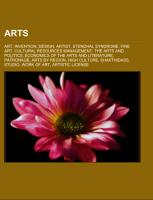- Start
- Arts
Arts
Angebote / Angebote:
Source: Wikipedia. Pages: 55. Chapters: Art, Invention, Design, Artist, Stendhal syndrome, Fine art, Cultural resources management, The arts and politics, Economics of the arts and literature, Patronage, Arts by region, High culture, ShakthiDass, Studio, Work of art, Artistic license, Untitled, Jealousy in art, Community arts, Interdisciplinary arts, Spirit of place, Art world, Gifted art, Artist's portfolio, Human figure, The Art of Man, Useful arts, Theme, Showpiece, Arts criticism, Acknowledgment, Artes Mechanicae, Artistic merit, Creative arts. Excerpt: Art is the product or process of deliberately arranging items (often with symbolic significance) in a way that influences and affects one or more of the senses, emotions, and intellect. It encompasses a diverse range of human activities, creations, and modes of expression, including music, literature, film, photography, sculpture, and paintings. The meaning of art is explored in a branch of philosophy known as aesthetics, and even disciplines such as history and psychology analyze its relationship with humans and generations. Traditionally, the term art was used to refer to any skill or mastery. This conception changed during the Romantic period, when art came to be seen as "a special faculty of the human mind to be classified with religion and science". Generally, art is made with the intention of stimulating thoughts and emotions. Philosopher Richard Wollheim distinguishes three approaches to assessing the aesthetic value of art: the realist, whereby aesthetic quality is an absolute value independent of any human view, the objectivist, whereby it is also an absolute value, but is dependent on general human experience, and the relativist position, whereby it is not an absolute value, but depends on, and varies with, the human experience of different humans. An object may be characterized by the intentions, or lack thereof, of its creator, regardless of its apparent purpose. A cup, which ostensibly can be used as a container, may be considered art if intended solely as an ornament, while a painting may be deemed craft if mass-produced. The nature of art has been described by Wollheim as "one of the most elusive of the traditional problems of human culture". It has been defined as a vehicle for the expression or communication of emotions and ideas, a means for exploring and appreciating formal elements for their own sake, and as mimesis or representation. Leo Tolstoy identified art as a use of indirect means to communicate from one person to another. Benedetto Croce
Folgt in ca. 5 Arbeitstagen
